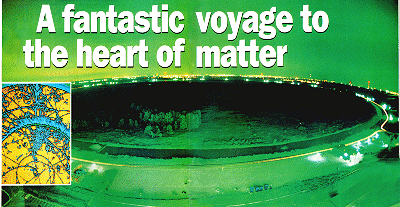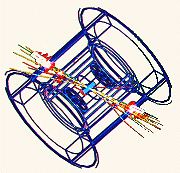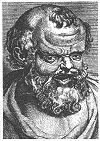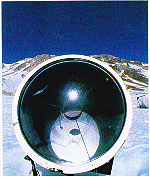Vast scale of the search for ultimate reality
This ring road near Chicago was built above a giant underground
particle accelerator. Two kilometres in diameter, the circular Tevatron is
employed in the hunt for the tiniest bits of matter. Beams of protons and
antiprotons (the antimatter versions of protons) whizz round the ring-shaped
tunnel. They collide at spends approaching that of light, creating energies
found at the heart of stars and recreating events that happened at the beginning
of time. Scientists are hoping to find among the showers of high-energy particles
thus produced, the elusive "top" quark, a fundamental particle that must
exist if their theories are right. |
 |
 A view of the weird world of particles A view of the weird world of particles
Left : As fast- moving particle beams collide in a powerful
detector, sprays of new particles are produced. Among the debris scientists
search for clues to understanding the fundamentals that underlie nature Inset
: subatomic particles created in gigantic machines reveal their exotic cosmic
dance as swirling tracks in a bubble chamber.
Science is close to solving the biggest mystery of all - how to make
sense of the particles that underlie all things |
The next time you put a lump of sugar in your coffee, take a good look at
it. Inside are the secrets of the universe. If you could look through a powerful
microscope, you'd see that each crystal is made of regular ring-like objects
- molecules. Further magnification reveals atoms of carbon, oxygen and hydrogen
about one- hundred-millionth of a centimetre across. These atoms - plus a
few others - make up all of life.
At greater magnification, you notice that these atoms have a structure. A
wavering cloud of insubstantial electrons surrounds a tiny dense nucleus
of the order of about one-hundred-million- millionth of a centimetre across.
| Democritus, who suggested that matter was made of indivisible
particles. The idea did not catch on for more than 2000 years after that |
 |
A nucleus is made of two kinds of particle - protons and neutrons. (Hydrogen
nuclei are simplest, with just one proton.) Nuclei are still being created
in the furnaces we call stars; its no coincidence that our bodies are composed
of the same proportions of the same atoms as the stars.
Electrons are thought to be "elementary" - not made up of more basic constituents
- but physicists have confirmed in the past 30 years that protons and neutrons
are made up of yet smaller particles:
"quarks". Here we are down to the unimaginable
scale of 10-15 of a centimetre.
Scientists think the elementary particles were created in the first moments
after the Big Bang, about 15 billion years
ago.
At CERN, the particle physics laboratory
in Geneva, scientists are hoping to build a giant new "genesis machine".
The Large Hadron Collider (LHC) will recreate the incandescence of the dawn
of creation. They hope this will tell them how matter came to be and reveal
what it is.
 |
Cosmic rays
This telescope in Italy is studying gamma rays and other sub-atomic
particles coming from space. These zap air molecules and create showers of
new particles like those made in accelerators. |
This would be a unifying theory - it would explain how quarks, electrons
and other particles interact. Scientists try to achieve this by treating
as particles the fundamental forces of nature - gravity, electromagnetism
and nuclear forces - that act upon the constituents of the atom.
While this concept of "force particles" is relatively new, the notion that
matter is made of elementary constituents is old. The Greek mathematician
Democritus believed matter was made of atoms. (The Greek atomos means
uncuttable.) Isaac Newton, the first
to suggest that light is made of particles, supported the theory, but it
wasn't till the 19th century that "atomism" gained support - partly because
it was useful for explaining chemical reactions. But many scientists still
did not regard atoms as real. At the end of the 19th century J J
Thompson, a British scientist, showed that electricity is borne by tiny
negatively charged corpuscles called electrons, and much less massive than
an atom. Ernest Rutherford, experimenting with radioactivity a few
years later, observed that alpha radiation fired at gold foil is sometimes
deflected. He proposed that gold atoms contain a tiny positively charged
nugget of material - a nucleus.
By the 1930s scientists had unravelled the structure of the atom. Also,
Albert
Einstein had shown that matter and energy are interchangeable, and that
light is made of "packets" of energy called photons.
Things didn't stay as simple as that.
Paul
Dirac suggested that a positively charged electron could exist, and the
discovery of "positrons", and of other
so-called antimatter particles in cosmic rays, soon followed. Particle
accelerators, which smash particles at high energies and create showers of
"strange" particles, were developed. The result was that by the end of the
19505 there were dozens of new particles with confusing names like the kaon
and the lambda. When the muon was discovered, one exasperated physicist asked
"Who ordered that?"
In 1962 Murray Gell-Mann and Yuval Ne'eman used
their notion of symmetry to order the particles into families. Gell- Mann
went on to suggest that all particles were built of smaller units - "quarks"
(a term from James Joyce's Finnegan's Wake). Evidence of quark-like entities
was found in protons, and further particles made of different kinds of quark
were discovered.
Find out more
-
The Particle Explosion Frank Close, Michael Marten and Christine Sutton
(OUP £20.00)
-
Dreams of a Final Theory Steven Weinberg (Hutchinson Radius
£16.99)
 Mar94 p52
Mar94 p52

 A view of the weird world of particles
A view of the weird world of particles

